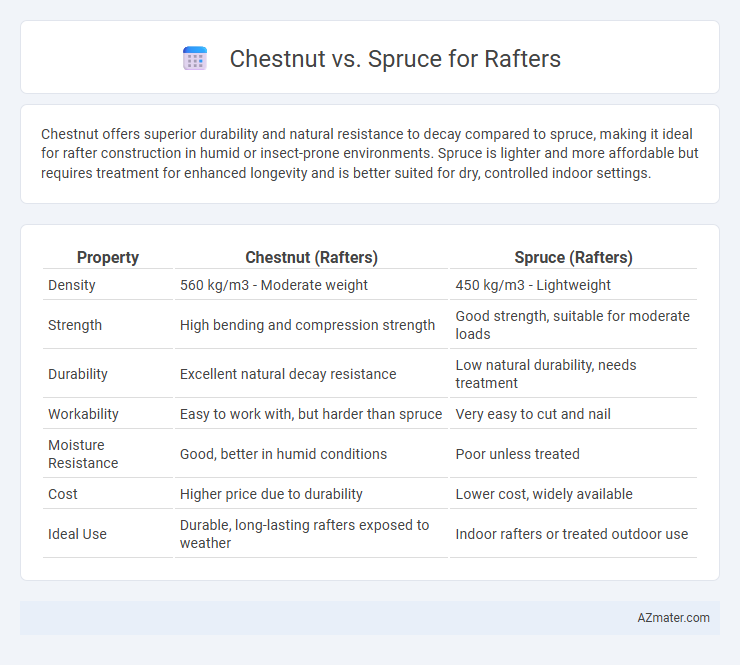Chestnut offers superior durability and natural resistance to decay compared to spruce, making it ideal for rafter construction in humid or insect-prone environments. Spruce is lighter and more affordable but requires treatment for enhanced longevity and is better suited for dry, controlled indoor settings.
Table of Comparison
| Property | Chestnut (Rafters) | Spruce (Rafters) |
|---|---|---|
| Density | 560 kg/m3 - Moderate weight | 450 kg/m3 - Lightweight |
| Strength | High bending and compression strength | Good strength, suitable for moderate loads |
| Durability | Excellent natural decay resistance | Low natural durability, needs treatment |
| Workability | Easy to work with, but harder than spruce | Very easy to cut and nail |
| Moisture Resistance | Good, better in humid conditions | Poor unless treated |
| Cost | Higher price due to durability | Lower cost, widely available |
| Ideal Use | Durable, long-lasting rafters exposed to weather | Indoor rafters or treated outdoor use |
Introduction: Comparing Chestnut and Spruce for Rafters
Chestnut and spruce are popular choices for rafters due to their distinct structural properties and availability. Chestnut offers high durability and natural resistance to decay, making it ideal for long-lasting roof frameworks. Spruce provides excellent strength-to-weight ratio and workability, allowing easier handling and installation in construction projects.
Wood Properties: Chestnut vs Spruce
Chestnut wood offers excellent durability and natural resistance to decay, making it suitable for rafters in outdoor or humid environments, while spruce is lighter and has a higher strength-to-weight ratio, providing efficient load-bearing capacity. Chestnut features a coarse texture and moderately high density, contributing to its robustness, whereas spruce has a fine, uniform grain with exceptional flexibility, ideal for structural framing. Spruce's straight grain and ease of workability contrast with chestnut's tougher fibers, influencing the choice based on specific construction needs for rafters.
Strength and Durability Differences
Chestnut offers superior durability and resistance to decay compared to spruce, making it a long-lasting choice for rafters in exterior and high-moisture environments. Spruce, while lighter and easier to work with, generally exhibits lower strength and is more prone to fungal attacks and insect damage. For structural applications requiring high load-bearing capacity and longevity, chestnut's dense grain provides greater overall strength and enhanced resistance over spruce.
Resistance to Pests and Decay
Chestnut wood exhibits higher natural resistance to pests and decay compared to spruce, making it a more durable choice for rafters in environments prone to insect activity and moisture exposure. Spruce, while commonly used due to its availability and lightweight properties, lacks the inherent protective tannins found in chestnut, resulting in a greater vulnerability to rot and wood-boring insects. Selecting chestnut for rafters ensures improved longevity and structural integrity, especially in outdoor or humid conditions.
Availability and Cost Considerations
Chestnut rafters offer limited availability due to the tree's reduced commercial harvesting, leading to higher costs compared to spruce. Spruce rafters are widely available and more affordable, making them a common choice for construction projects needing budget-friendly materials. Cost fluctuations in chestnut are driven by rarity and demand, while spruce benefits from sustainable supply and lower market prices.
Workability and Construction Ease
Chestnut offers superior workability for rafters due to its lightweight nature and straight grain, allowing easier cutting, shaping, and nailing compared to denser Spruce. Spruce, while harder and slightly more durable, can be more challenging to work with due to its higher density and tendency to splinter under improper handling. Construction ease generally favors Chestnut for faster assembly and reduced tool wear, making it an optimal choice for efficient rafter installation.
Environmental Impact and Sustainability
Chestnut rafters are known for their sustainability due to fast growth rates and renewable harvesting, contributing to lower environmental impact compared to slower-growing spruce. Spruce, although widely used and lightweight, often involves larger-scale forestry operations that can affect biodiversity and soil health negatively if not managed sustainably. Selecting chestnut over spruce supports carbon sequestration efforts and promotes responsible forestry practices that enhance long-term ecosystem resilience.
Aesthetic Qualities and Visual Appeal
Chestnut rafters offer a rich, warm tone with distinctive grain patterns that enhance rustic and traditional architectural styles. Spruce rafters provide a lighter, more uniform appearance with fine, straight grain, ideal for modern or minimalist designs. Both woods present unique aesthetic qualities, but chestnut stands out for its warm color and character, while spruce excels in brightness and subtlety.
Maintenance Needs Over Time
Chestnut rafters demand less frequent maintenance due to their natural resistance to rot and insect damage, extending their lifespan without intensive care. Spruce rafters require regular inspections and treatments with preservatives to prevent moisture damage and pest infestation, increasing upkeep efforts. Selecting chestnut reduces long-term maintenance costs and preserves structural integrity more effectively than spruce.
Best Applications: When to Use Chestnut or Spruce
Chestnut is best suited for rafters requiring high durability and resistance to decay, making it ideal for outdoor or exposed roofing structures. Spruce excels in indoor or sheltered applications due to its lightweight nature and ease of handling, providing sufficient strength for typical residential roofing. For heavy-load or long-span rafters, chestnut's superior hardness ensures better performance, whereas spruce is preferred for cost-effective, moderate-load scenarios.

Infographic: Chestnut vs Spruce for Rafter
 azmater.com
azmater.com